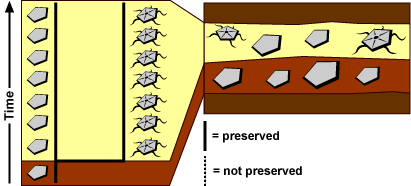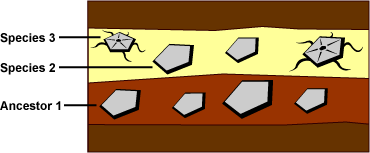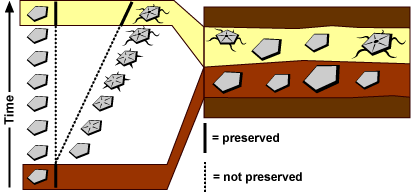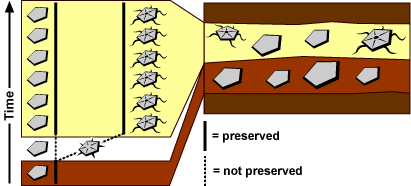In many cases, we seem to observe “bursts” of evolution in the fossil record. For example, imagine that in a lower rock layer, you see ancestor 1. In the next rock layer, you see species 2 and 3. Species 2 looks the same as ancestor 1. Species 3 is morphologically distinct, but is clearly also descended from ancestor 1. What happened?
The fossils we have are only “time slices” of actual history. Several different hypotheses about what happened when are consistent with these fossil time slices. In order to determine which of the following hypotheses most accurately explains the pace of evolution, we’d need more evidence.
Phyletic gradualism — slow steady divergence of lineages
The “burst” of evolution is a geological illusion. It only looks like a burst because a lot of time — say, 5 million years — passed between the times when the two rock layers were laid down. In this period of time, species 3 gradually diverged from ancestor 1 through a series of transitional forms, but these transitional forms were not preserved.
Punctuated equilibrium — a large amount of change in a short time tied to a speciation event
Species 2 and 3 are only 100,000 years younger than ancestor 1, and all the evolutionary change connecting them took place in this short time. The “burst” of evolution is really a burst. Transitional forms between ancestor 1 and species 3 did exist, but for such a short amount of time that they were not preserved in the fossil record.
Macromutation — a big mutation produces sudden evolutionary change skipping over transitional forms
The “burst” of evolution is really a burst — there was a lot of evolutionary change in a very short amount of time. Species 3 was produced by a mutation that radically changed the offspring of ancestor 1 in many ways. Such extreme mutants are sometimes called “hopeful monsters.” This hypothesis is consistent with the fossils; however, based on other observations, we do not have clear evidence that such extreme yet adaptive mutations generally occur. Nevertheless, it is possible that mutations affecting development have far-reaching phenotypic effects and have played an important role in the evolution of life.




